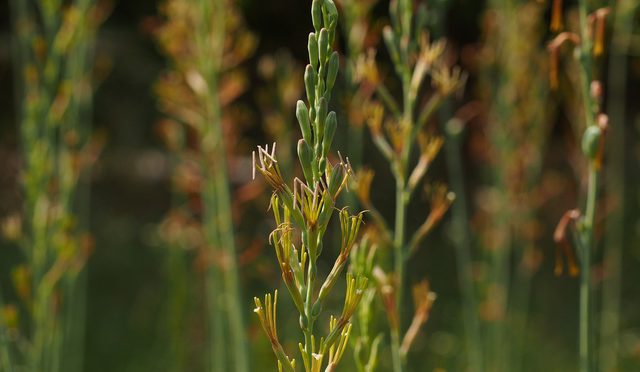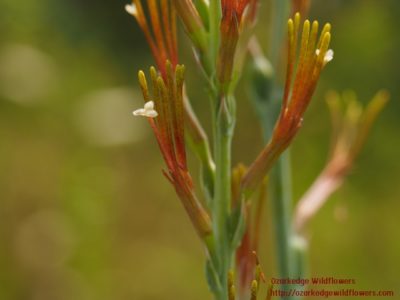Manfreda virginica was one of the key native plants that ignited my passion for wildflowers. I first experienced it as a girl when I was exploring the open Arkansas woods. An unusual tall green wand that gently waved in the evening breeze caught my sight and an intoxicating fragrance drew me to it. Nose to flower, I tried to place the interesting aroma. I had never smelled a fragrance anything like it from another flower. It brought to mind the clove chewing gum I had from time to time. What an intriguing plant and fascinating fragrance! Because it captured my imagination, I learned to spot the basal rosettes in the glades and woodlands and watch them over the season until they sent up their tall wands and produced the fragrant flowers I loved to smell. I hope you will find the opportunity to smell their amazing fragrance one day, too.
Latin Name/Common Name- I can’t find the name Manfreda in my Stearn’s Dictionary of Plant Names for Gardeners. Wikipedia states the name honours the 14th-centure Italian Manfredus de Monte Imperiale. I researched a little about him and learned that he was an important scholar who wrote about medical botany. You can read more about him and other European minds who influenced botanical history in The Naming of Names: The Search for Order in the World of Plants.
A previous latin name for Manfreda virginica was Agave virginica.
The most used common name is False aloe, but its also known by Virginica agave and Rattlesnake master. The common name of Rattlesnake master is problematic as it is typically used for a different but somewhat similar plant- Eryngium yuccifolium.
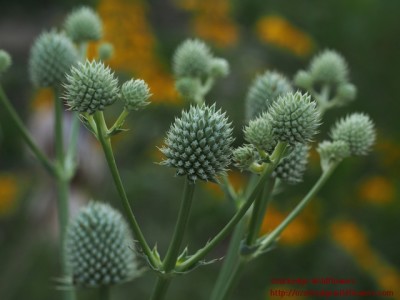 This is the plant more commonly known as Rattlesnake Master- Eryngium yuccifolium
This is the plant more commonly known as Rattlesnake Master- Eryngium yuccifolium
Bloom Color- The tiny flowers of Manfreda virginica are white with a slight greenish or yellowish tint.
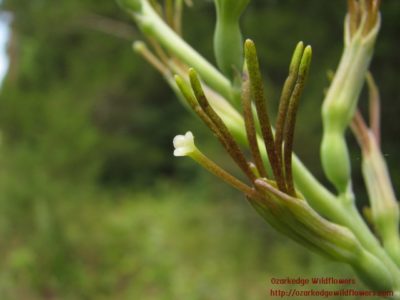 Tiny flower from Manfreda virginica
Tiny flower from Manfreda virginica
Description- Manfreda virginica is an agave plant arising from a bulb.
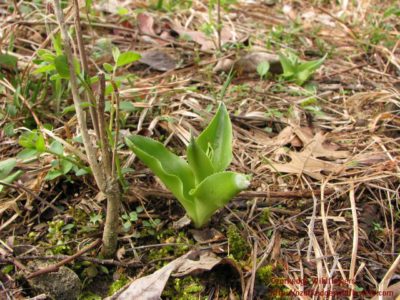 Waxy, succulent leaves arise in spring to form a basal rosette
Waxy, succulent leaves arise in spring to form a basal rosette
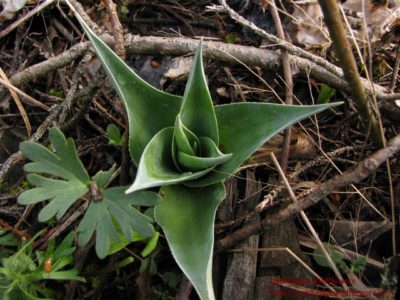 Leaves have pointed tips and lightly toothed edges. Some may have purplish spots near the leaf base.
Leaves have pointed tips and lightly toothed edges. Some may have purplish spots near the leaf base.
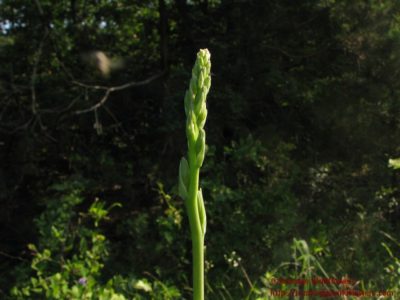 A tall stem or wand arises from the plant in early summer
A tall stem or wand arises from the plant in early summer
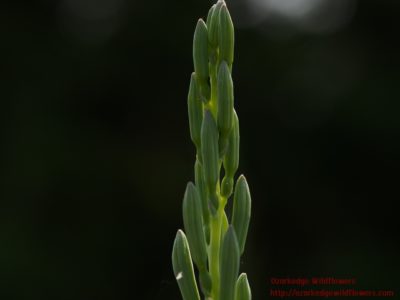 The stem, containing numerous flower buds reaches a height of 5 -6 feet
The stem, containing numerous flower buds reaches a height of 5 -6 feet
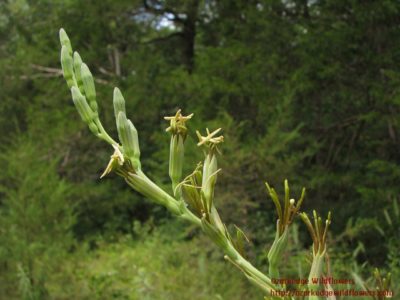 The buds open first from the base and proceed to the tip of the wand
The buds open first from the base and proceed to the tip of the wand
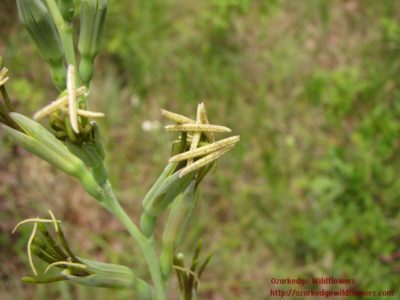 Yellow anthers with reddish-brown dots form a criss-cross pattern
Yellow anthers with reddish-brown dots form a criss-cross pattern
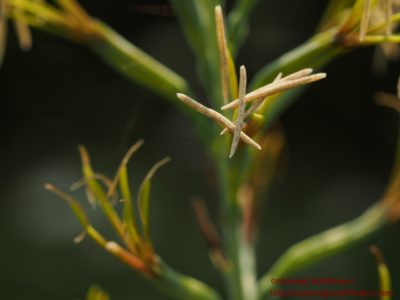 The large anthers dominate and are the most interesting flower feature
The large anthers dominate and are the most interesting flower feature
Flowering begins from the bottom and proceeds to the top of the stalk. Nectar is found in the bottom of the calyx tube. The clove-like fragrance of the flowers begins around dusk and persists until dawn. Female and male sexual parts mature at different times to prevent self-pollination. Each tiny flower opens in the early hours of the day. Later the same day, the anthers dehisce (release the pollen) around dusk. The next evening the stigma will be ready for pollination (receptive), and will remain so until the following day.
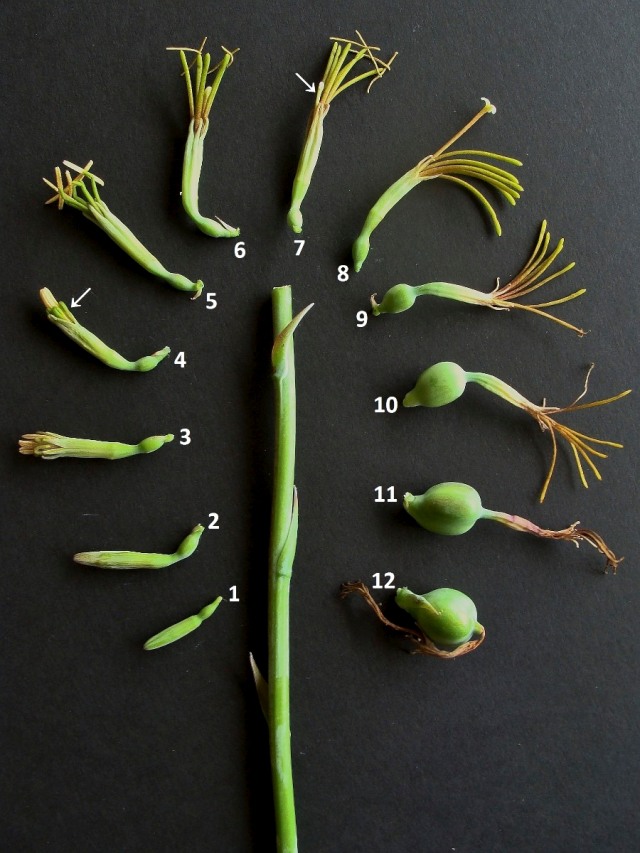 This illustration demonstrated the sequential flower development in Manfreda virginica
This illustration demonstrated the sequential flower development in Manfreda virginica
* Vogelpohl, Sid. “Know Your Natives- False Aloe” ANPS.org link [16 July. 2015}
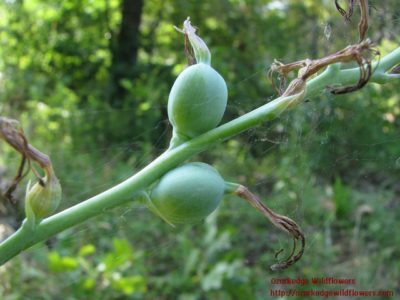 Fresh seed pods are green and will ripen to dark brown
Fresh seed pods are green and will ripen to dark brown
Bloom Time- On Ozarkedge, the flowers of Manfreda virginica arrive toward the end of June or beginning of July.
Habitat- Manfreda virginica is found in rocky glades, open and rocky woods and prairies. On Ozarkedge, it’s found in glades and at the edges of rocky woods.
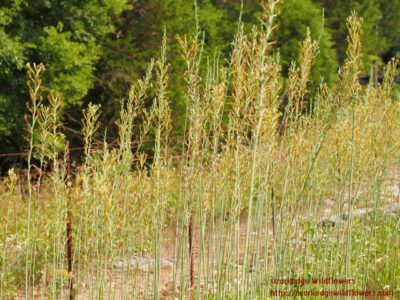 Hundreds of False aloe growing in a glade habitat
Hundreds of False aloe growing in a glade habitat
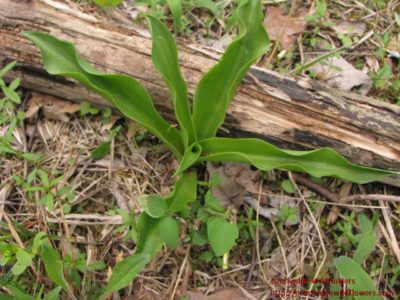 False aloe growing in open woods
False aloe growing in open woods
What’s Growing Nearby? Many beautiful plants occupy the rocky glades and open woodland habitat of Manfreda virginica. Below are a few of my favorites that are found blooming nearby.
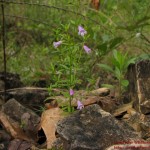
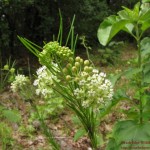
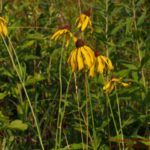 Calamintha arkansana Asclepias verticilata Echinacea paradoxa
Calamintha arkansana Asclepias verticilata Echinacea paradoxa
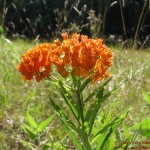
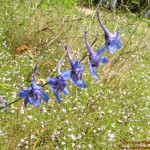
 Asclepias tuberosa Delphinium carolinianum Matalea decipiens
Asclepias tuberosa Delphinium carolinianum Matalea decipiens
Endangered List- USDA shows the native range of Manfreda virginica stretching from North Carolina west to Texas, encompassing all of the southern states. It’s range extends as far north as Illinois. The Legal Status tab on the site lists it as Threatened in Ohio.
It is Not Ranked in most states on the NatureServe site. In states with rankings, it is shown as Critically Imperiled in West Virginia, Imperiled in Illinois and Viriginia, Vulnerable is Indiana, Ohio and North Carolina and Apparently Secure in Kentucky.
Interesting Tidbits-
Pollination of Manfreda virginica occurs mostly at night by sphinx (and other smaller) moths with sphinx moths being the most important. Diurnal pollination (during daylight) is less effective, occurring primarily from large bees.
It’s very interesting to know that the tomato (or tobacco) hornworm many vegetable gardeners love to hate is the larvae of the sphinx moth. We should keep that in mind next time we see one chomping on our precious tomato foliage. Perhaps we can work on a more generous frame of mind towards them.
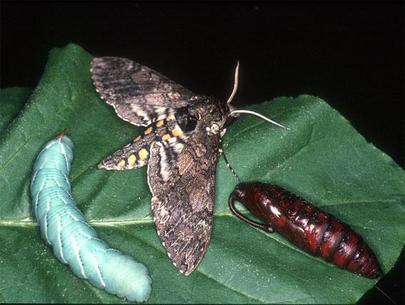 Here’s a picture showing the life cycle of the Sphinx moth*
Here’s a picture showing the life cycle of the Sphinx moth*
* You can visit an entomology site with more information about their life cycle including how to differentiate between the tobacco and tomato hornworm here (you will have to scroll down the page to get to the information).
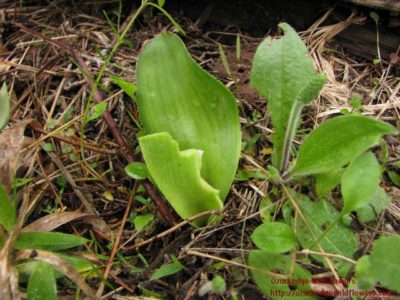
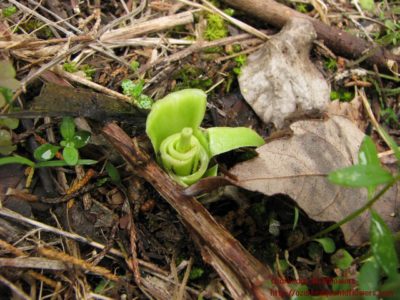 I read online that Manfreda virginica is a fairly deer and rabbit resistant plant. This is NOT my experience. I find they are particularly loved in the early spring when the basal rosettes first arise. They must taste particularly delicious at this time-see above examples of entire plants nearly consumed by deer.
I read online that Manfreda virginica is a fairly deer and rabbit resistant plant. This is NOT my experience. I find they are particularly loved in the early spring when the basal rosettes first arise. They must taste particularly delicious at this time-see above examples of entire plants nearly consumed by deer.
